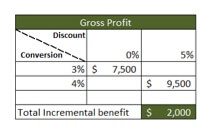Shoppers will be looking for discounts on holiday items in the next few weeks. If designed right, a promo code can offer the discounts shoppers seek, and help merchants increase sales and profits. Creating a promo code isn’t as simple as sticking a 10 percent off label on everything. It needs to be designed to drive maximum benefit to your business.
In this post, I’ll address how to create an effective promo code.
What Is a Good Promo Code?
A good promo code is one that helps a site’s shoppers as well as the business itself.
A promo code should be attractive to shoppers. There are three rules to remember to accomplish this. The promo code should be:
- Easy to remember;
- Easy to calculate;
- Easy to apply.
I’ll touch on each of these. An easy-to-remember promo code uses everyday words. For example “Thanksgiving2015” or “BlackFriday2015” are easy to remember. “PROMOA342” is not. Make it easy on the shoppers, not on you.
The promo code discount should be easy to calculate by using round numbers. For example, 10 percent off is much easier to compute than 14 percent off. Similarly $20 off all orders over $100 is easy to calculate.
Finally, the easier the promo code is to apply, the more it will be used and the more transactions you will have. This means it should have minimal restrictions on date, product type, locations, and other factors. Do not make your shoppers think. When they think, they hesitate. And when they hesitate, they might leave your site without purchasing.
Holiday Business Goals
Not all businesses will have the same goals for the holidays. Some might want to obtain a certain gross profit while others might want to drive awareness. Three common goals of ecommerce merchants are:
- Hitting a certain gross profit target;
- Acquiring new customers while not losing money;
- Moving surplus inventory.
These three goals can be boiled down to the same promo code calculation with a few variations. I’ll use an example to explain. You will need access to your analytics data to adapt this calculation to your situation.
Sample Promo Code Calculation
Assume a company, Cool Widgets, sells gadgets on its website, which has the following key metrics.
- Monthly traffic: 25,000 visitors.
- Average conversion rate: 3 percent.
- Average order value: $100.
- Gross profit margin: 50 percent.
Based on its marketing efforts, Cool Widgets expects to receive 20 percent of its monthly traffic on Black Friday. It is considering offering a straight discount across all products, and it assumes the conversion rate will increase as the discount increases.
While that is a reasonable assumption, there will likely be a point where, despite increasing the discount rate, the conversion rate will stabilize. But let’s say that conversion does increase as the discount offered increases.
So what needs to be calculated is the incremental benefit Cool Widgets should expect as a result of offering a promo code.
First, if Cool Widgets did not offer any discount on Black Friday, it can expect to make $7,500 in gross profit on Black Friday. Here’s how we arrive at that calculation.

Calculate Cool Widgets’ expected gross profit as: Traffic x Conversion Rate x Discount Rate x Average Order Value x Gross Profit Percentage. (5,000 x 3% x $100 x 50% = $7,500.)
So, offering discount promo codes needs to generate more than $7,500 of gross profit to be worthwhile. Cool Widgets believes that offering a discount of 5 percent across the board will increase the conversion rate from 3 percent to 4 percent.
Calculating the incremental benefit is easy.

Offering a discount of 5 percent across the board will increase the conversion rate to 4 percent, which will produce an extra $2,000 of gross profit.
So Cool Widgets stands to make an extra $2,000 if it offers a discount of 5 percent across the board. By repeating the above calculation for a range of discount rates and conversion rates, we can now determine which discount rate will drive the maximum benefit.

Applying the calculation for a range of discount rates and conversion rates, Cool Widgets can determine which discount rate will drive the maximum benefit.
The highlighted cells, above, show how the incremental benefit changes by discount rate offered and by conversion rate increases. Plotting the same table on a chart makes it clear what the peak for Cool Widgets benefits is.

A discount of approximately 30 percent will give Cool Widgets the maximum incremental benefit of $7,500.
A 30 percent discount will produce the maximum incremental gross profit of $7,500 to Cool Widgets, assuming that the conversion rate will increase as the discount offered increases. So Cool Widgets now has a formula to double its projected gross profit on Black Friday from $7,500 to $15,000.
This is a simplistic model that assumes a straight discount across all products. To apply it to your business, tweak the model for the goals you want to hit, such as acquiring new customers at breakeven or getting rid of surplus inventory.
Depending on the nature of your business, here are a few things to consider when building your promo code model.
- Memberships. Existing members show more loyalty than non-members. If members account for most of the site’s revenue, then offering a promo code may not increase overall conversion rate by much.
- Product mix. If the mix of products on the site have a large price variance, then the average order value may be misleading and the products may need to be evaluated using multiple discounts and conversion rates.
- Channel focus. If the Black Friday traffic will have a different channel mix — i.e., paid search, organic search, social, email — compared to an average month, then adjust the conversion rate based on the expected channel mix.
In short, taking time to carefully design your promo codes can pay off for your business this holiday season. And while you can include a slew of wrinkles into the model to increase the accuracy, the basic idea is to get to a ballpark figure of what the discount percent should be, and not necessarily to get it down to a decimal point of accuracy.




